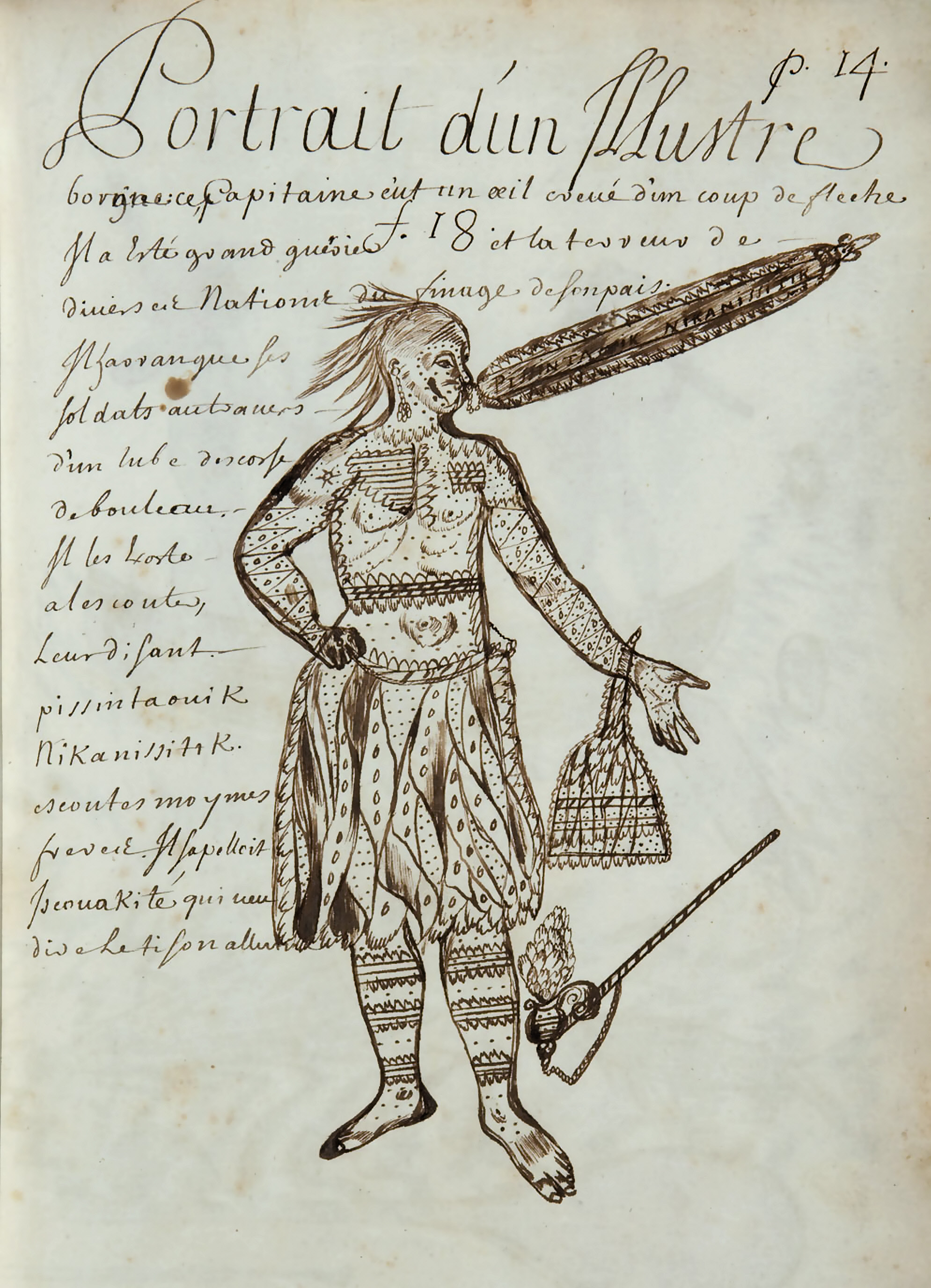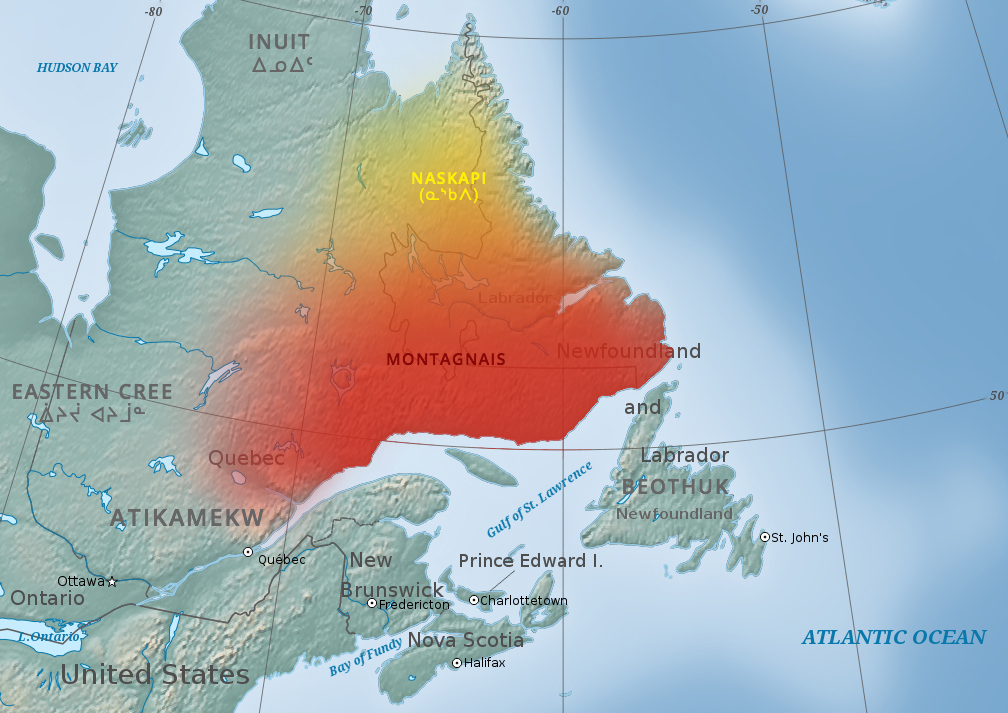|
Pieskaret
Pieskaret (pronounced ''pees-ka'-ret'') (died 1647) was a famous chief of the Adirondac Indians. His tribe fought against the English forces, helping the French in the early 17th century. The Adirondacs under him drove the Iroquois Confederation out of Canada. Known as "the terror of the Iroquois", Pieskaret (also variously spelled or rendered Pieskaret, Diescaret, Piescars) was the chief of the Tessouat tribe, whose territory lies in present-day Quebec. The name Pieskaret means "Little Blaze", and was most likely a French corruption of an Algonquin name which includes the word Piskone, which means "lights a fire". To the colonials, Pieskaret was known by his Christian name, Chief Simon. Pieskaret was a distinguished war leader who was known for his exploits against the Iroquois. The Iroquois were enemies of the Algonquin at that time. Chief Pieskaret was a French ally and also an early Catholic convert. The Algonquins described him as " a very brave man," and the Jesuits wrote t ... [...More Info...] [...Related Items...] OR: [Wikipedia] [Google] [Baidu] |
Algonquin People
The Algonquin people are an Indigenous people who now live in Eastern Canada. They speak the Algonquin language, which is part of the Algonquian language family. Culturally and linguistically, they are closely related to the Odawa, Potawatomi, Ojibwe (including Oji-Cree), Mississauga and Nipissing, with whom they form the larger Anicinàpe (Anishinaabeg). Algonquins call themselves Omàmiwinini (plural: Omàmiwininiwak) or the more generalised name of Anicinàpe. Though known by several names in the past, such as ''Algoumequin'', the most common term "Algonquin" has been suggested to derive from the Maliseet word (): "they are our relatives/allies." The much larger heterogeneous group of Algonquian-speaking peoples, who, according to Brian Conwell, stretch from Virginia to the Rocky Mountains and north to Hudson Bay, was named after the tribe. Most Algonquins live in Quebec. The nine recognized status Algonquin bands in that province and one in Ontario have a combined ... [...More Info...] [...Related Items...] OR: [Wikipedia] [Google] [Baidu] |
Iroquois Confederation
The Iroquois ( or ), officially the Haudenosaunee ( meaning "people of the longhouse"), are an Iroquoian Peoples, Iroquoian-speaking Confederation#Indigenous confederations in North America, confederacy of First Nations in Canada, First Nations peoples in northeast North America/Turtle Island (Native American folklore), Turtle Island. They were known during the Colonial history of the United States, colonial years to the French as the Iroquois League, and later as the Iroquois Confederacy. The English people, English called them the Five Nations, comprising the Mohawk people, Mohawk, Oneida people, Oneida, Onondaga people, Onondaga, Cayuga people, Cayuga, and Seneca people, Seneca (listed geographically from east to west). After 1722, the Iroquoian-speaking Tuscarora people from the southeast were accepted into the confederacy, which became known as the Six Nations. The Confederacy came about as a result of the Great Law of Peace, said to have been composed by The Great Peacem ... [...More Info...] [...Related Items...] OR: [Wikipedia] [Google] [Baidu] |
Canada
Canada is a country in North America. Its ten provinces and three territories extend from the Atlantic Ocean to the Pacific Ocean and northward into the Arctic Ocean, covering over , making it the world's second-largest country by total area. Its southern and western border with the United States, stretching , is the world's longest binational land border. Canada's capital is Ottawa, and its three largest metropolitan areas are Toronto, Montreal, and Vancouver. Indigenous peoples have continuously inhabited what is now Canada for thousands of years. Beginning in the 16th century, British and French expeditions explored and later settled along the Atlantic coast. As a consequence of various armed conflicts, France ceded nearly all of its colonies in North America in 1763. In 1867, with the union of three British North American colonies through Confederation, Canada was formed as a federal dominion of four provinces. This began an accretion of provinces and ... [...More Info...] [...Related Items...] OR: [Wikipedia] [Google] [Baidu] |
Tessouat
Tessouat (''Anishinaabe'': Tesswehas) ( c. ??? – 1636–1654) was an Algonquin chief from the Kitchesipirini nation ("Kitche"=Great, "sipi"=river, "rini"=people: the people from the great river, the Ottawa River). His nation lived in an area extending from Lake of Two Mountains to modern-day Pembroke, Ontario. Tessouat lived in L'Isle-aux-Allumettes, in a neck of the Ottawa River. He was described by the French settlers as having a strong character. He was also blind in one eye (in French, borgne) and was dubbed "le Borgne de l'isle". His position was highly strategic, as the Ottawa River was the safest way to go from the St. Lawrence River to Hudson Bay and to Huronia, near Georgian Bay. Tessouat took advantage of his position to impose some sort of customs duties on the French fur traders navigating on the Ottawa River, as well as to impose some of his authority. For example, in 1633, he refused to let the Jesuits go to Huronia, fearing he would lose authority in the re ... [...More Info...] [...Related Items...] OR: [Wikipedia] [Google] [Baidu] |
Iroquois
The Iroquois ( or ), officially the Haudenosaunee ( meaning "people of the longhouse"), are an Iroquoian-speaking confederacy of First Nations peoples in northeast North America/ Turtle Island. They were known during the colonial years to the French as the Iroquois League, and later as the Iroquois Confederacy. The English called them the Five Nations, comprising the Mohawk, Oneida, Onondaga, Cayuga, and Seneca (listed geographically from east to west). After 1722, the Iroquoian-speaking Tuscarora people from the southeast were accepted into the confederacy, which became known as the Six Nations. The Confederacy came about as a result of the Great Law of Peace, said to have been composed by Deganawidah the Great Peacemaker, Hiawatha, and Jigonsaseh the Mother of Nations. For nearly 200 years, the Six Nations/Haudenosaunee Confederacy were a powerful factor in North American colonial policy, with some scholars arguing for the concept of the Middle Ground, in that Eu ... [...More Info...] [...Related Items...] OR: [Wikipedia] [Google] [Baidu] |
Trois-Rivières
Trois-Rivières (, – 'Three Rivers') is a city in the Mauricie administrative region of Quebec, Canada, at the confluence of the Saint-Maurice and Saint Lawrence rivers, on the north shore of the Saint Lawrence River across from the city of Bécancour. It is part of the densely populated Quebec City–Windsor Corridor and is approximately halfway between Montreal and Quebec City. Trois-Rivières is the economic and cultural hub of the Mauricie region. The settlement was founded by French colonists on July 4, 1634, as the second permanent settlement in New France, after Quebec City in 1608. The city's name, which is French for 'three rivers', is named for the fact the Saint-Maurice River has three mouths at the Saint Lawrence River; it is divided by two islands in the river. Historically, in English this city was once known as Three Rivers. Since the late 20th century, when there has been more recognition of Quebec and French speakers, the city has generally been referred to ... [...More Info...] [...Related Items...] OR: [Wikipedia] [Google] [Baidu] |
Mohawk People
The Mohawk people ( moh, Kanienʼkehá꞉ka) are the most easterly section of the Haudenosaunee, or Iroquois Confederacy. They are an Iroquoian-speaking Indigenous people of North America, with communities in southeastern Canada and northern New York State, primarily around Lake Ontario and the St. Lawrence River. As one of the five original members of the Iroquois League, the Kanienʼkehá꞉ka are known as the Keepers of the Eastern Door – the traditional guardians of the Iroquois Confederation against invasions from the east. Historically, the Kanienʼkehá꞉ka people were originally based in the valley of the Mohawk River in present-day upstate New York, west of the Hudson River. Their territory ranged north to the St. Lawrence River, southern Quebec and eastern Ontario; south to greater New Jersey and into Pennsylvania; eastward to the Green Mountains of Vermont; and westward to the border with the Iroquoian Oneida Nation's traditional homeland territory. Kani ... [...More Info...] [...Related Items...] OR: [Wikipedia] [Google] [Baidu] |
Wyandot People
The Wyandot people, or Wyandotte and Waⁿdát, are Indigenous peoples of the Northeastern Woodlands. The Wyandot are Iroquoian Indigenous peoples of North America who emerged as a confederacy of tribes around the north shore of Lake Ontario with their original homeland extending to Georgian Bay of Lake Huron and Lake Simcoe in Ontario, Canada and occupying some territory around the western part of the lake. The Wyandot, not to be mistaken for the Huron-Wendat, predominantly descend from the Tionontati tribe. The Tionontati (or Tobacco/Petun people) never belonged to the Huron (Wendat) Confederacy. However, the Wyandot(te) have connections to the Wendat-Huron through their lineage from the Attignawantan, the founding tribe of the Huron. The four Wyandot(te) Nations are descended from remnants of the Tionontati, Attignawantan and Wenrohronon (Wenro), that were "all unique independent tribes, who united in 1649-50 after being defeated by the Iroquois Confederacy." After th ... [...More Info...] [...Related Items...] OR: [Wikipedia] [Google] [Baidu] |
Innu
The Innu / Ilnu ("man", "person") or Innut / Innuat / Ilnuatsh ("people"), formerly called Montagnais from the French colonial period (French for "mountain people", English pronunciation: ), are the Indigenous inhabitants of territory in the northeastern portion of the present-day province of Labrador and some portions of Quebec. They refer to their traditional homeland as ''Nitassinan'' ("Our Land", ᓂᑕᔅᓯᓇᓐ) or ''Innu-assi'' ("Innu Land"). The Innu are divided into several bands, with the Montagnais being the southernmost group and the Naskapi being the northernmost. Their ancestors were known to have lived on these lands as hunter-gatherers for several thousand years. To support their seasonal hunting migrations, they created portable tents made of animal skins. Their subsistence activities were historically centred on hunting and trapping caribou, moose, deer, and small game. Their language, Ilnu-Aimun or Innu-Aimun (popularly known since the French colonial ... [...More Info...] [...Related Items...] OR: [Wikipedia] [Google] [Baidu] |
Year Of Birth Missing
A year or annus is the orbital period of a planetary body, for example, the Earth, moving in its orbit around the Sun. Due to the Earth's axial tilt, the course of a year sees the passing of the seasons, marked by change in weather, the hours of daylight, and, consequently, vegetation and soil fertility. In temperate and subpolar regions around the planet, four seasons are generally recognized: spring, summer, autumn and winter. In tropical and subtropical regions, several geographical sectors do not present defined seasons; but in the seasonal tropics, the annual wet and dry seasons are recognized and tracked. A calendar year is an approximation of the number of days of the Earth's orbital period, as counted in a given calendar. The Gregorian calendar, or modern calendar, presents its calendar year to be either a common year of 365 days or a leap year of 366 days, as do the Julian calendars. For the Gregorian calendar, the average length of the calendar ye ... [...More Info...] [...Related Items...] OR: [Wikipedia] [Google] [Baidu] |
1647 Deaths
Events January–March * January 2 – Chinese bandit leader Zhang Xianzhong, who has ruled the Sichuan province since 1644, is killed at Xichong by a Qing archer after having been betrayed one of his officers, Liu Jinzhong. * January 7 – The Westminster Assembly begins debating the biblical proof texts, to support the new Confession of Faith. * January 16 – Citizens of Dublin declare their support for Rinuccini, and refuse to support the army of the Marquis of Ormond. * January 17 – Posten Norge was founded as Postvesenet. * January 20 – A small Qing force led by Li Chengdong captures Guangzhou and kills the Zhu Yuyue, the Shaowu Emperor of the Southern Ming dynasty in China. * February 5 – The Yongli era is proclaimed as Zhu Youlang is declared the Yongli Emperor of the Southern Ming. * February 24 – Thomas Bushell surrenders the Bristol Channel island of Lundy, the last remaining Royalist territory of England, to the Pa ... [...More Info...] [...Related Items...] OR: [Wikipedia] [Google] [Baidu] |







